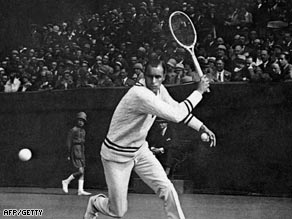 I. Introduction
Watching Nikolay Davydenko's recent victory over Juan Del Potro in the Barclay's Masters Tournament in London and listening to Andre Agassi's recent Interview with 60 Minutes had me thinking about a theory on timing and control of the ball.
I. Introduction
Watching Nikolay Davydenko's recent victory over Juan Del Potro in the Barclay's Masters Tournament in London and listening to Andre Agassi's recent Interview with 60 Minutes had me thinking about a theory on timing and control of the ball.
II. The theory
What is my theory? It's this.
Timing and control, is seems to me, really about 3 things: the ball, the palm of your hitting hand, and the sweet spot of the racket head. And above all, the absolute unity and syncronizing of these 3 objects in the tennis stroke.
III. Davydenko and Agassi
What was seen at the Davydenko match and said at the Agassi inteview?
*It's about timing: Davydenko's masterful ability to take the ball on-the-rise, thereby short-circuiting the big-hitting power game of Delpo.
*It's about control: His artful short-angled shots to his opponent's sidelines, pulling Delpo out wide repeatedly.
*It's about the palm of the hand: Aggasi's re-telling of that famous story about his father's home-rigged ball machine "The Dragon" which spit out balls at over 100+ MPH at the young Agassi in training...his racket, hand, palm and ball probably became a single blur, and thus honed the extra-ordinary hand-eye coordination of the one of the best on-the-rise hitters in history.
IV. The assumptions
Now, let's look at the two assumptions of my theory just a bit closer: Only the racket head sweet spot touches the ball, and only the player's palm of hand touches the racket head sweet spot via the racket handle.
A. Only the racket head sweet spot properly contacts the ball
Bill Tilden, in his classic book How to Play Better Tennis (1950), put it this way, and it is still true today: "[The] all-important fact...is the head of the racquet and only the head of the racquet returns a ball in tennis."
Thus, since the very beginning, the only thing which properly touches the ball from the player in any stroke or rally is: the sweet spot of the racket head.
B. Only the palm of the hand is connected to the sweet spot via the racket handle
The sweet spot is located in the center of the racket head. The racket head is physically connected by a handle to the hand's palm. Thus, the palm of hand and only the palm of hand is in physical touch (indirectly) with the sweet spot.
Typically, the hand's palm is approximately 15 to 20 inches or so from the sweet spot. The challenge of the good timing, therefore, is to operate the stroke mechanic in a way so as to reduce that distance, in the player's mind-eye, down to zero.
V. Conclusion
Simply: The ball, the racket sweet spot and the palm of the hand must work in unison to achieve and maximize timing and control.
VI. Post Script: A few other points on timing made by other writers worth considering here:
1. The myth of watching the ball hit the racket strings - Vic Braden, in his book Mental Tennis explained that watching the tennis ball hit the racket strings is essentially impossible for the human eye. Based on his high speed filming and research with ophthalmologists, a ball is only on a racket string about 3 milliseconds, which is a time frame the human eye cannot record. In fact, Braden later clarified that the human eye begins to lose focus on moving objects within a 3 feet radius. Mental Tennis, Vic Braden, Little Brown (1993), Pages 180-182.
2. Keeping the head still and fixed on the contact zone throughout and after the stroke - This then becomes the actual purpose of "watching the ball". The head, which is the heaviest part of the human body, is kept quiet, and thus removed it from the equation so as to produce a balanced and stable stroke mechanic. Research has consistently shown that top level players keep their upper body, especially head, absolutely still on the their strokes. Watch how long, for example, Federer's head stays fixed on the contact point, even after the ball has left his racket.
3. Feeling "connected" to the racket head sweet spot, by not gripping the handle too tightly between the fingers, but pushing it directly onto the palm. Most players simply grip the handle much too tightly, and thus "feel" not the racket head sweet spot, but just the tenseness of their forearm. A critical component of timing: the player "feels" the literal weight of the racket head sweet spot as it moves towards the ball. In fact, many players use other techniques such as aiming the butt of the racket handle at the in-coming ball on their stroke, and making use of the non-dominant hand in the take-back, to help them achieve this "feel". "Timing and Feel of the Racket Head", Don Brosseau, www.tennisplayer.net
4. The crux movement in the on-the-rise stroke mechanic - Coiling the racket and sinking the body before the ball bounce, and then uncoiling and lifting before the ball reaches it's apex is the methodology of hitting on the rise. "Two Secrets of Timing", Scott Murphy, www.tennisplayer.net
5. Jeu de Paume - The original French name for tennis was "Jeu de Paume" (game of the palm). The fact that the very name of tennis is described with the palm of the hand implies the critical importance of hand timing.
6. Command of the racket head sweet spot is the master key to timing - Consider what Agassi recently commented about the World's Number One Player: What sets Federer apart from all the others is his phenomenal ability to control the racket head.
Best, Gary


























